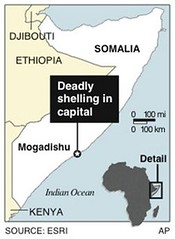
Map of area in Somalia where attacks were made by the resistance forces against the US-backed President who was boarding a plane enroute to Uganda. AMISOM and funding from the Obama administration has kept the TFG barely afloat.
Originally uploaded by Pan-African News Wire File Photos
Updated: 07/09/2010 16:00
Somali war takes heavy toll on trapped civilians - U.N.
Another 400 people have been wounded in the war zone of Somali government forces and hardline Islamist rebels, and many civilians are no longer able to reach safety in neighbouring countries, UNHCR spokeswoman Melissa Fleming said.
Around 23,000 residents have fled Mogadishu over the past two weeks, many on foot, others forced to give away their last possessions to buy a seat on a small bus out of town, she said.
The streets of Mogadishu were deserted with people too afraid to leave their homes due to heavy shelling, according to Somali refugees reaching the semi-autonomous Somali enclave of Puntland in the north, or neighbouring Ethiopia and Kenya.
"One woman who escaped told us, 'All you see in the streets are bodies of people killed by bullets or mortars'," Fleming told a news briefing in Geneva.
"People are increasingly becoming trapped in a war zone -- fleeing Mogadishu has itself become more dangerous and difficult," she said.
The Horn of Africa country has been plagued by anarchy since warlords ousted military dictator Mohamed Siad Barre in 1991.
Aid distribution has become rare in Mogadishu, where at least 300,000 displaced are struggling to survive, according to UNHCR, which lacks a current figure for the capital's population.
Al Qaeda-linked al Shabaab militants have waged a three-year insurgency against the fragile Western-backed transitional government and they now control much of Mogadishu and huge tracts of southern and central Somalia.
They have vowed to intensify their jihad (holy struggle) against the African Union-backed government of President Sheikh Sharif Ahmed, a former Islamist rebel who is now regarded by militants as a Western puppet.
FORCED RECRUITMENT
Somalis fleeing Mogadishu face new risks and difficulties, reporting that they fear forced recruitment and abuse by militias in southern Somalia, according to UNHCR.
More than 300,000 people are now staying in makeshift camps along the Afgoye corridor 30 km (19 miles) southwest of the capital, an area deemed relatively safe.
"(Being) trapped within their own country is becoming more and more of a reality for many Somalis," Fleming said.
"This conflict has been going on for over a decade and it used to be easy to get out. It's becoming increasingly dangerous and increasingly difficult to escape," she said.
Somalis say they have to pass numerous checkpoints manned by armed groups before reaching the Gulf of Aden coast in the north to board smugglers' boats bound for Yemen, she added.
Only 7,300 Somalis have reached Yemen by boat so far this year, half of the figure during the same period last year.
Some 37,000 Somali refugees reached Kenya through August, down by one-third compared to the first eight months of 2009. Ethiopia is the only neighbouring country to show a steady rise in Somali arrivals, with more than 20,000 this year.
"People are escaping in the directions that they hear are more safe, but some of them are not making it," Fleming said.
In all, nearly 68,000 Somalis have fled their homeland this year to other countries in the region. Somalia continues to generate the largest number of refugees in the world after Afghanistan and Iraq, according to the UNHCR.
There are more than 614,000 Somali refugees worldwide and more than 1.4 million Somalis displaced within Somalia.
(Editing by Mark Heinrich)
No comments:
Post a Comment